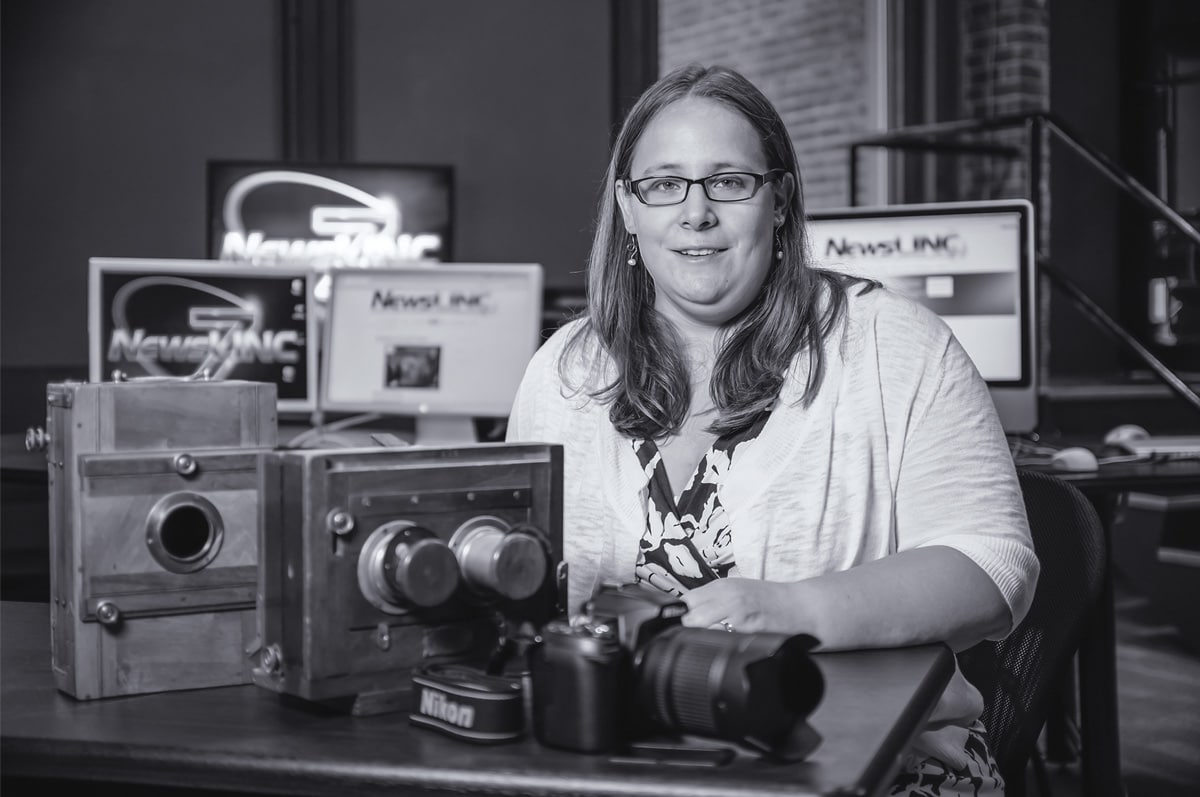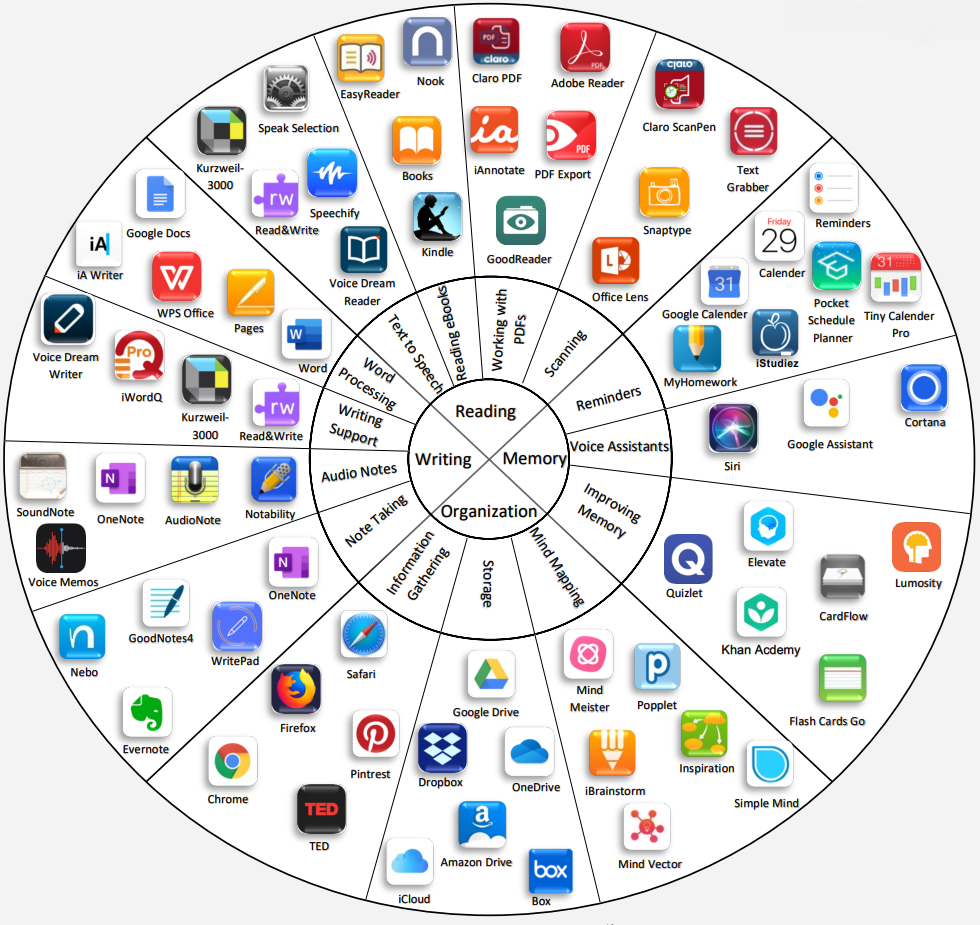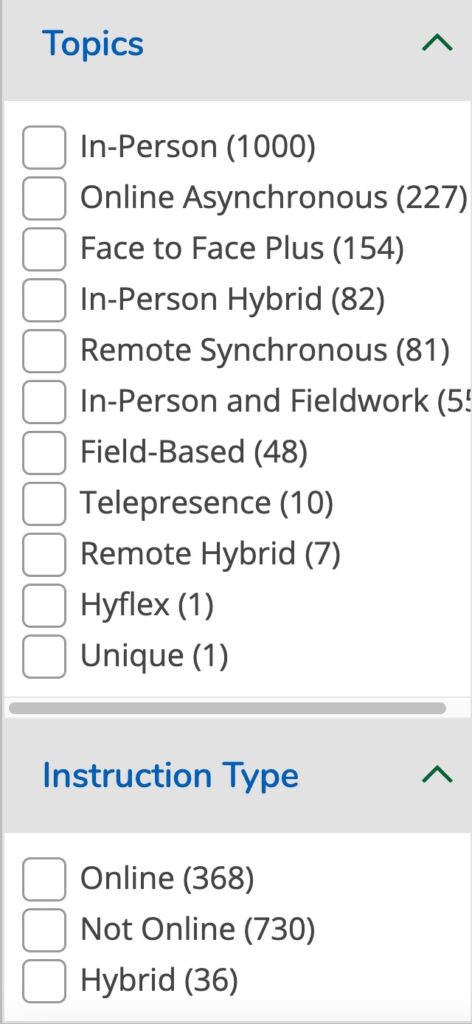April 2024 | Issue 9 | Volume 1 | Previous Issues
Two Years of F2F+ Teaching & Learning at VTSU
The Face-to-Face Plus (F2F+) courses at VTSU provide two access points to synchronous classes. Students can be in-person with the instructor or remote via Zoom, allowing increased access to courses and majors.
In Summer 2022, a group of 26 faculty formed a pilot cohort of instructors preparing to teach in the Face-to-Face Plus (F2F+) modality. There was a total of 25 courses in each of the Fall and Spring semesters. This cohort of faculty participated in an intensive Summer 2022 experience (a kick-off retreat and a 6-week class). Then during the entire 2022-23 academic year, they engaged in peer-support cohorts to troubleshoot and process their teaching experience, attended workshops throughout the year, and participated in a day-long retreat in January. As a Community of Practice, these faculty helped the CTLI prepare resources to onboard new colleagues to this modality, derived from literature on good bimodal teaching practices as well as from their own experiences.
Students who took courses in the F2F+ modality shared key insights about their learning experiences, directly with their instructors through course-level surveys and other feedback methods as well as through a university survey. Student respondents to the university survey (n=162) generally had a positive experience in their course; 81% Strongly Agreed or Agreed that they were satisfied with their F2F+ Course Experience while only 4% Strongly Disagreed or Disagreed. Students were given 7 options (plus “other) and asked to choose which two they valued the most. The options with the highest number of responses were (1) flexibility to attend either in-person or remote, (2) a student-centered professor who cares about all students, and (3) increased access to a class not offered on their campus.
While student satisfaction is important, it does not always correlate to students’ learning. While success in a course is not a perfect proxy for learning, either, VTSU’s Director of Institutional Research has aggregated the F2F+ sections to compare passing and DFW rates to the same courses offered not in the F2F+ modality, both within the current academic year and to the prior academic year. The rates of success were on par, a positive trend.
| AY22-23 | AY21-22 | ||||||||
| F2F+ Course Enrollments (#N) | (#N) Passing (A-C, Passing) | (%) F2F+ Success Rate | Non F2F+ Course Enrollments (#N) | (#N) Passing (A-C, Passing) | (%) Non F2F+ Success Rate | Total Course Enrollments (#N) | (#N) Passing (A-C, passing) | (%) Success Rate | |
| #Students | 856 | 760 | 88.79% | 1338 | 1178 | 88.04% | 1845 | 1636 | 88.67% |
In Summer 2023, an additional 52 faculty participated in professional development via a full-day retreat and a one-month ‘Intro to F2F+ Teaching’ class. Utilizing the backward design process, faculty made intentional choices about how to engage and support both in-person and remote students, including building community early in the semester across access points and ensuring interaction between students and with course content. These faculty, under the mentorship of experienced F2F+ instructors and CTLI staff, also planned and practiced effective integration of technology to facilitate learning as they crafted detailed lesson plans.
“I learned what I can do and was in a way, “forced” to think about how to make the class work with remote and in-class learners at the same time. Ultimately what I learned will even help me improve my in-person teaching.”
VTSU Faculty Member – Participating in the CTLI-sponsored ”Intro to F2F+ Teaching’ professional development class.
Summer of 2023 also saw technology upgrades to many classrooms on all five campuses. The Learning Technologies team listened to feedback from faculty and students about some of the challenges in the pilot, including installing additional and higher-quality microphones and interactive monitors.
During the 2023-24 school year, each semester, there have been approximately 150 F2F+ classes offered. We are looking forward to pulling success rate data at the conclusion of the academic year, with the hypothesis that success rates in F2F+ classes will surpass those in other modalities (which are predominantly in-person), given the increased access and flexibility afforded by the F2F+ modality. And the CTLI is looking forward to supporting faculty as they continue to design new F2F+ courses.
Summer and Fall 2024 – Syllabus Templates Available
Each semester, the CTLI publishes an updated syllabus template, to stay current with policies, context, and the dates of the semester. No matter what modality you’re teaching in, the syllabus can be edited to meet your needs. While the template appears to be lengthy, it will become much shorter when you tailor it to your course (deleting the highlighted language, which is instructional for you).
The Summer and Fall 2024 Syllabus Templates can be previewed and downloaded from the CTLI website.
If you are reusing an old syllabus, be sure to match these updates from the new templates:
- The Credit Hours and Student Work subsection (under the “About the Course” section) was updated to reflect the new VTSU Credit Hour policy (passed by the Faculty Assembly in March 2024).
- A subsection on Artificial Intelligence was added to the Class Expectations section – we encourage you to create course-level expectations either by writing your own policy or co-creating one with your students.
- The Office of DEISJ was added to the Inclusivity & Equity subsection.
- The schedule of activities was updated with relevant 2024 dates, including space for you to fill in important cut-off dates for adding, dropping, and withdrawing.
The goals of the syllabus templates are twofold:
- To make your life easier – you don’t have to look up the dates of the semester or make sure your syllabus reflects current policy.
- To create consistency for students – consistent organization of syllabi, Canvas course spaces, assignment sheets, and other teaching materials reduces cognitive burden (extraneous cognitive load) for students, allowing them more capacity to focus on the important cognitive task of learning. There are additional applications of cognitive load theory for teaching.
Given this second goal of consistency, we also encourage you to adopt the CTLI Canvas Template. This template allows you full freedom to customize the content of the course and focuses exclusively on the organization and structure of the course. The more classes that adopt the template, the easier it is for students to find what they need quickly, reducing frustration and emphasizing class engagement.
Faculty Spotlight
Professor Meaghan Meachem, Lyndon Campus

In this issue of the Vermont State Educator, we are highlighting the background, experiences, and perspectives of Lyndon-based professor, Meaghan Meachem. We are also pleased to share her thoughts on F2F+ teaching and building community within her classrooms.
Please tell us a little bit about your background and what brought you to VTSU.
I first came to Lyndon as a student interested in atmospheric science. Like many before me, the math kicked my butt, so I perused a degree in television design and production after talking to the chair of the program about my passion for photography. I was a teaching assistant for the program my senior year, and my advisor and mentor at the time encouraged me to think about teaching. Five years later, after getting laid off from a news position and getting my master’s degree, a position opened back up at Lyndon for someone to move the program to web platforms, and it was kismet. I’ve been working as a faculty member since 2008, and have been leading my colleagues in the program since 2016.
Between graduating from Lyndon and returning as a faculty member I focused a lot of my energies beyond news on digital learning environments and web tools that could enhance a student’s learning experiences. I spent time creating and cultivating educational programming at a public access channel in southern Vermont and also have been a consultant for many non-profits in areas of communications and public relations.
What are your favorite things about your field or discipline?
The reason I love journalism is that it isn’t a desk job. You’re learning about the communities you serve every day, interacting with the communities and people who you serve every day and finding those stories that need to be told. Journalism can also afford you once in a lifetime experiences and send you all over the world. I’ve been fortunate in my career within News to meet world leaders, presidents, musicians, and lots of community members doing fantastic things. I also love that journalism is ever evolving to suit the needs of every generation and has to evolve and change. It makes teaching journalism that much more exciting when we get to be on the forefront of making change.
As an experienced Face-to-Face Plus (F2F+) instructor, what do you do to build rapport and community within your F2F+ classrooms?
It’s not just about being an experienced F2F+ instructor, but it’s about being one who’s still willing to learn new tools, play with them, and admit that you can still learn too. It’s sometimes important to be humble and flexible teaching in this modality. Because that can help build rapport and community within the classroom. Not every tool works for every student. So listening to their experiences with how you’re teaching and modifying to better their experiences yields a better long term experience for the students. Every once in a while (once or twice a term), I make sure we have a class where everyone, regardless of how they attend, attends remotely so that the students who are zooming in get to be on the same playing field as those who get to attend in person. It builds community among the students.
Do your F2F+ active learning strategies differ from those used in your face-to-face classes?
Showing the new generations of students how to engage while in a remote or F2F+ classroom looks different no matter what you do. It’s easy to hide behind a screen and not always pay attention. So what you have to do to engage a remote student takes ten times more energy than working solely in a face to face environment. So yes, my active learning strategies look a little different…but only because I need to knock down the barrier of the screen and make students attending remotely equally as heard and engaged as those right in front of you.
What advice or tips do you have for faculty members who would like to teach a course in the F2F+ modality for the first time?
Flexibility is the name of the game. Not every tool you’re going to use works for every class you may teach in this modality. And if something doesn’t work the first time, spend some time to think about why it didn’t work so that you can either change your approach next time or so you can learn what doesn’t work for a certain class. It’s important to maintain pedagogical integrity…even if it means you use some old school basics to keep students engaged. It’s not always about the newest technology.
Get Paid to Develop your F2F+ Course Using Evidence-Based Practices
Are you creating or converting a class to teach in the Face-to-Face Plus (F2F+) modality next year? (Re)Designing a course for a new modality is a significant investment of time. This is especially true for F2F+ classes, where intentional planning is essential for ensuring that remote and in-person students are engaged in active learning and have equitable experiences. This paid professional development opportunity exists to support you to successfully design and teach courses in this modality.
| F2F+ Structural Considerations | F2F+ Pedagogical Hallmarks |
| Instructor-student contact is fulfilled through synchronous class sessions. | Backward design is utilized to ensure alignment between learning objectives, assessments, instructional materials, and teaching/learning activities. |
| Students join from multiple access points (in the classroom, from home, from another campus). | Instructors facilitate active learning. |
| While students register for their primary access point (remote or in-person), there is flexibility if students need to adjust their access point temporarily or permanently. | Scaffolding provides support for all students to engage in meaningful learning. |
| Requires use of educational technology. | Accessibility and equity of experience are prioritized and mediated by technology. |
The CTLI applied for a new round of funding for 2024 for a project titled “Prioritizing Access Through ‘Face-to-Face Plus’ Expansion + OER Adoption,” and VTSU was awarded $216,261, the bulk of which is allocated for faculty stipends. The grant was received from the Davis Educational Foundation established by Stanton and Elisabeth Davis after Mr. Davis’s retirement as chairman of Shaw’s Supermarkets, Inc.
| Limited Funding Availability – Apply as an Individual (Rolling Application) |
| Attend a full-day kick-off retreat on May 22. Compensation: $300 |
| Complete a 4-week ‘Intro to F2F+ Teaching’ course in June •4-6 hours per week of attendance and homework (synchronous, offered in the F2F+ modality) •Complete a F2F+ course redevelopment map •Complete at least 2 F2F+ class lesson plans (practice 1) •Work with a Mentor to plan, revise, and develop F2F+ teaching Compensation: $1250 |
| Summer & Fall Continuation Work •Complete 4 additional F2F+ lesson plans that address active learning & multimodal engagement in July •Practice with classroom technology •Work with a Mentor to plan, revise, and develop F2F+ teaching •Contribute to ”lessons learned” through focus group participation, surveys, or semi-structured interviews Compensation: $500 |
Please apply as an individual to convert a course to the F2F+ modality. Selected individuals will take a 4-week synchronous course in June 2024, during which they’ll map out the outcomes, assessments, and learning activities for a F2F+ course then design lesson plans for teaching in the F2F+ modality. Additional support will be provided for effective integration of technology. Faculty who have participated in this program in the past are eligible to apply, as long as you are converting a new class that you haven’t previously converted.
There are still spots for ~15 faculty to take advantage of this opportunity. Applications will be reviewed on a rolling basis.
If you have questions about any of them, please reach out to the CTLI at ctli@vermontstate.edu.
Resource Spotlight
Educational Apps

Recognizing the increasing use of educational apps to support or drive active learning in the classroom, the Center for Teaching & Learning Innovation has added guides to several apps in the Teaching with Technology section of our website. Members of the faculty are encouraged to adopt a new technology to support your teaching while also sharing lessons learned and success stories with your peers!
Although there are many apps on the market, as shown in the wheel of apps graphic, these guides focus on some of the most frequently used resources:
Teaching Strategies
Building Community and Engagement in Face-to-Face Plus (F2F+) Classes
As outlined in the Face-to-Face Plus (F2F+) Teaching Guide, students taking courses offered in this modality are able to access synchronous class meetings in two ways: (1) attending class in-person at a set location or (2) attending class synchronously online over a video conferencing platform. While this modality is advantageous in many regards, such as extending educational opportunities to students living in remote areas, it can present some challenges in building a classroom culture and community that is on par with courses taught in a more traditional format.
Based on available literature and the feedback of VTSU faculty members, below are some recommendations for instructors teaching in a F2F+ modality for the first time:
Integrate Active Learning Strategies
Active learning is an umbrella term and generally means teaching and learning that is not traditional lecture in which students are passively learning. Active learning asks students to grapple with content, engage in problem-solving, explore and interrogate their thinking, and often work with peers to co-create meaning.
Begin the process by downloading and considering examples of active learning strategies that promote student interaction, especially those that involve discussion and collaborative creation. Before incorporating these strategies, however, it is recommended that they are aligned with the objectives of the course and developed as low rather than high stakes exercises.
Try Collaborative Annotation
Social annotation tools, such as Perusall, allow faculty members to upload a variety of course resources (e.g., PDF documents, lecture slides, videos, articles) that students are able to review and annotate online. This process encourages them to ask questions, share perspectives, and respond to the annotations and questions posed by other members of the class. This type of collaborative engagement not only increases the likelihood that class materials will be read, it encourages relational learning within the course.
Speak with a Colleague
A number of VTSU faculty members have taught in this modality and are well-positioned to share effective F2F+ teaching strategies. For example, the following feedback was provided by mathematics professor, Linda Segovia Wise, in the November 2023 issue of the Vermont State Educator. “During class I use Nearpod, Zoom polls, and group work to keep “Roomies” (in-person students) and “Zoomies” (remote students) engaged. I use the Zoom polls to check-in with students and keep track of their attention. Seeing students work in real-time in Nearpod keeps them accountable and helps guide my teaching.” In addition to faculty peers, instructors are also welcome to contact and brainstorm with a staff member with the Center for Teaching & Learning Innovation.
Q&A about F2F+ with Heather Morrison – VTSU Registrar

Thank you to Heather Morrison, VTSU’s Registrar, for taking some time to share relevant information about Face-to-Face Plus classes.
What would the Registrar’s Office like faculty to know about F2F+ classes?
This is a great way to open your class up to students on other campuses and ensure your class doesn’t risk getting cancelled for low enrollment. If you are interested in offering even greater flexibility for your students, consider the Hyflex modality, which is just like F2F+, but adds an asynchronous option, which is especially helpful to students who may have rigid work schedules or even athletes.

Why are there 2 subsections for each F2F+ class?
There are two subsections so that we can have accurate records of those students that are taking the course in-person versus remote. This information is important for our international students as well as those who are using Veterans Affairs (VA) benefits to pay for their education. Both of these subsets have restrictions on the number of remote courses that they can take in a semester.
How can a student, advisor, or faculty locate F2F+ classes in the Web Schedule/Search for Sections?
There are now a set of filters that are available on the course listings to allow folks to locate courses by VTSU modality, including F2F+. Once you have selected a VTSU semester, you will see an option on the left menu labeled “Topics” that lists all ten of VTSU’s modalities.
If you selected “Face to Face Plus” the remote subsections of these courses will be displayed on screen (the in-person subsections will be included in the “In-Person” filter).
How can someone tell the total enrollment across the two subsections of a F2F+ class?
In the Web Schedule/Search for Sections, the first column displays the Seats for each class, with three numbers displayed. The first number shows the available open seats. The second number is the capacity or limit for enrollment in the course. And the third number shows the number of students on the waitlist.
The total possible enrollment for a F2F+ course (across the two subsections) will be the number listed in the second column for either subsection. In the example, below, both subsections show a capacity of 18. That does not mean there are 36 seats available for the course. The 18 is a maximum enrollment across the two subsections.
To calculate a “live count” of enrolled students for the course, you need to complete a simple calculation. Add the seats available from the first column, and deduct that from the course capacity. In the example below, there are 10 available seats in the in-person subsection and 6 available seats in the remote subsection, totalling 16 available seats. Since the course has a capacity of 18, there are currently 2 students enrolled in the course.

How does a faculty member shift open seats from one subsection to another (e.g., create open spaces in the remote subsection and close spaces in the in-person subsection)?
The Registrar’s Office is still trying to determine the easiest way for faculty to do this without jumping through a bunch of hoops. A plan will be forthcoming later this month (April 2024) – stay tuned!!
For more information, including contact information, a staff listing, and important links, visit the Registrar’s Office Sharepoint site.
From the VSCS Libraries: OER Open Hours

Do you have burning questions about Open Educational Resources (OER) and slashing those dreaded textbook costs? Fear not; there’s no such thing as a silly or cringe-worthy question! Swing by the newly created drop-in office hours on the first and third Fridays of each month, from 10am-12pm with the VSCS Librarians. Pop in for a quick chat or linger awhile, whether you’re a fresh-faced OER newbie, a seasoned veteran, or wandering somewhere between. Visit calendar.libraries.vsc.edu to obtain the Zoom link for the date you’d like to attend.
Mark Your Calendar! Keynote Speaker Robin DeRosa

The CTLI is pleased to announce that on Friday, April 26 from 12:30-2:00pm, Robin DeRosa, will be delivering a keynote address for VTSU staff and faculty titled “Teaching Toward an Open Future.” This session will be on Zoom and recorded for anyone who cannot make it.
Session Description: Higher Education is in flux. Sometimes it feels like change is the only constant in our work lives as faculty and staff. There can be pressure to innovate, as well as anxiety about what might be lost if we radically transform our practices. We might even wonder if the values that motivate us as scholars, teachers, or support staff are reflected in our institutions, given how constrained they are by the ebb and flow of politics and markets. In this presentation, Robin will propose that we use Open Education as a bridge to help us cross from higher education’s current challenges into a more hopeful future where our colleges and universities are vehicles for the public good, powered by the people who work and learn within them. By aligning our values with our pedagogies and linking the university to the communities that surround and sustain it, we can imagine a way forward and design our daily work to bring us one step at a time toward the higher education that our students deserve.
While this session ties to our F2F+ OER efforts, it should also be inspiring, uplifting, and empowering for any educator at VTSU.
Please register for this keynote to receive the Zoom link and calendar invitation.
VSCS Retreat: Artificial Intelligence

Mark your calendar, now, for a VSCS-wide retreat focused on Artificial Intelligence on Thursday, August 8 at the Randolph Campus. This event is open to all VSCS faculty and staff and sponsored by the Teaching and Learning with Technology (TLT) system-wide committee. More details will be forthcoming about speakers and sessions.